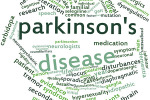

Parkinson’s Disease (PD) is a neurological movement disorder that happens when certain brain neurons become impaired and can no longer produce dopamine. Dopamine is a chemical that is important for relaying messages between different parts of the brain to help control movements in the body. This is what allows people to have smooth movements. Parkinson effects are not noticeable until 60 – 80% of the cells that produce dopamine are compromised.
become impaired and can no longer produce dopamine. Dopamine is a chemical that is important for relaying messages between different parts of the brain to help control movements in the body. This is what allows people to have smooth movements. Parkinson effects are not noticeable until 60 – 80% of the cells that produce dopamine are compromised.
In the United States, as many as one million people live with Parkinson’s Disease, and there are 60,000 new cases diagnosed every year. Parkinson’s tends to impact senior citizens the most, with almost 1% of Americans over the age of 65 experiencing some form of the disease. About 4% of those with the disease are younger than 50. This can be a difficult diagnosis at any age. There is a specific website for young-onset Parkinson’s which is quite helpful.
Early diagnosis of PD is important, so that its progression can be stopped or slowed. It is important to watch for the following changes:
A neurological examination is important to determine if the diagnosis is PD or another neurological disorder. This involves taking a medical history, asking about signs and symptoms, and observing how the patient moves, including coordination and balance.
Diagnosis can’t be done with blood tests, EEGs, MRIs or CT scans. The changes that create this type of degenerative disease are microscopic, and can’t be seen through these tests. What can be seen in a good diagnostic exam by a Neurologist with an expertise in movement disorders is what will prove to be definitive in a true diagnosis of Parkinson’s. A Neurologist with this skill knows how changes in body functions relate to various areas of the brain.
The fact that cases tend to vary greatly from person to person can make diagnosis and treatment quite hard. A Neurologist must evaluate a patient’s complete medical history to give the appropriate neurological examination and evaluate the symptoms affecting the patient first hand. Some people may experience symptoms of PD, without actually having the disease. This is called Parkinsonism, and is usually caused by medication, blocked blood vessels in the brain and other chronic medical conditions.
Tremors are usually the first of the symptoms to manifest in the beginning, and tend to be quite mild, affecting only one side of the body. The symptoms tend to worsen over time, with the tremors affecting one’s ability to perform tasks that require hand movement. The symptoms of PD can have a huge impact on your day-to-day life, affecting even the simplest of routine habits, such as taking a shower or making breakfast. Symptoms tend to get worse on a case-by-case basis, with no accurate prediction of when symptoms will develop.
Parkinson’s Disease is a progressive disease that cannot be reversed. It is important to work with your medical team if you have PD: your primary doctor, a neurologist, a physical therapist, and possibly a psychologist. There are, however, things you can do to potentially prevent it, and treatment options to control and ease the symptoms if you have it.
Here are some ways in which you can help keep symptoms under control if you have PD, and potentially lower your risk for PD.
1. Change Your Diet
Some studies have shown that a lack of folic acid may put you at risk for PD. Incorporate fresh, raw vegetables into your diet to up your intake of folic acid. Eat foods rich in Omega 3‘s such as pasture-raised meats, edamame, wild rice, walnuts, flax seeds, and cold-water fish. Omega-3 has amazing anti-inflammatory properties. Try to avoid processed foods, grains, and non-organic produce/meat.
2. Drink More Green
Tea Green tea has a group of naturally occurring chemical substances known as green tea polyphenols (GTP) that are high in antioxidants. New studies have shown that these GTPs have neuro-protective qualities, which means they can protect the dopamine neurons that are destroyed by PD.
3. Take Your Vitamins
There are a few vitamins which can be helpful in preventing and controlling PD. B vitamins and zinc help reduce homocysteine, which if elevated can be toxic, and has been linked to PD. Vitamin D is another great vitamin to take, since it enhances the brain-derived neurotrophic factor and has anti-inflammatory properties. Finally, you can take magnesium as it can help you sleep better, acting as a natural relaxant.
4. Avoid Pesticides
Pesticides have been linked directly to the development of Parkinson’s Disease. Try to avoid any chemicals when gardening, and buy organic produce whenever possible.
5. Exercise
Physical activity is both recommended for the prevention and alleviation of symptoms of PD. Tai chi has been shown to be especially helpful in reducing falls and improving balance in those with this health challenge. Other exercise regimes like Yoga, strength training, balance training, and bicycling have also been used very successfully.
You can keep the symptoms under control by exercising and maintaining a healthy diet. It’s vital that you remain communicative with your friends and family if you develop PD, as depression and isolation are common side effects for those living with this disease. Work with your medical team to find the most effective medications. There are surgical options that are available, and medical trials that are available as research is finding our more about this disease.
To find out more about Parkinson’s disease, visit the National Parkinson’s Foundation website.
To see other resources available, go to our Video and Other Media page.
© 2014 Designing Brighter Tomorrows Inc.
This site is for information only, and is for your voluntary use at your own risk. See Terms of Use